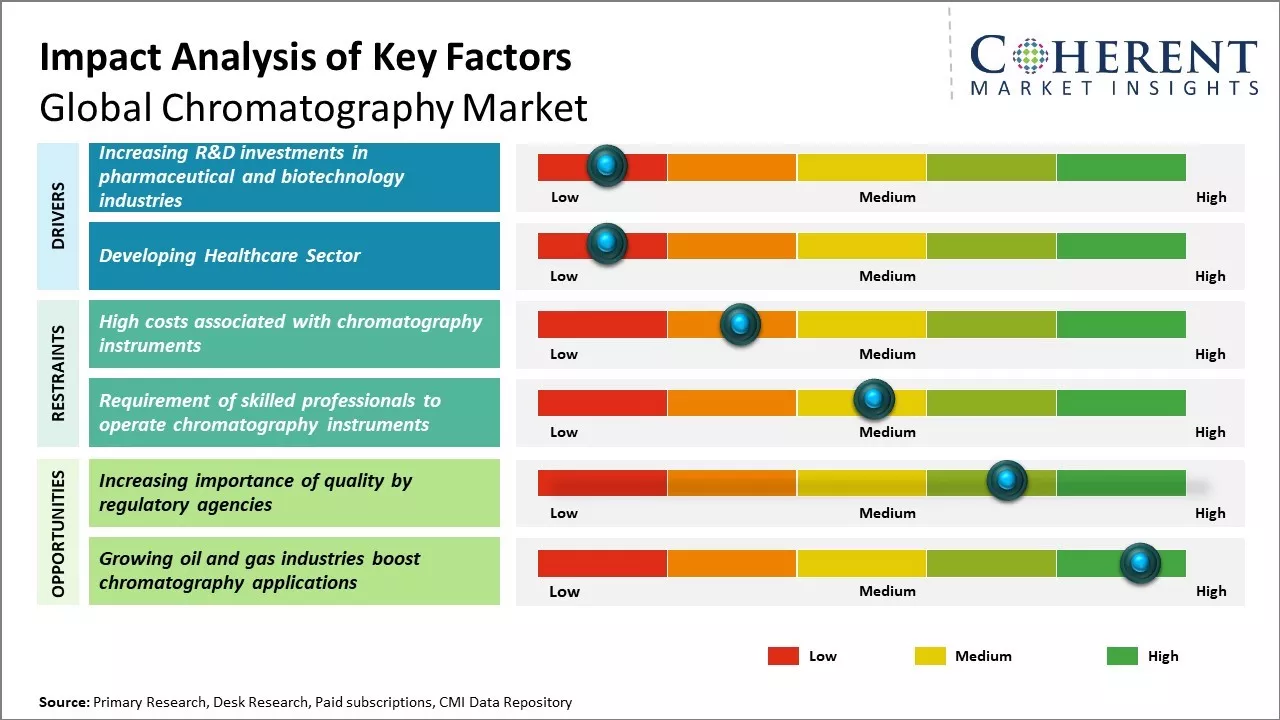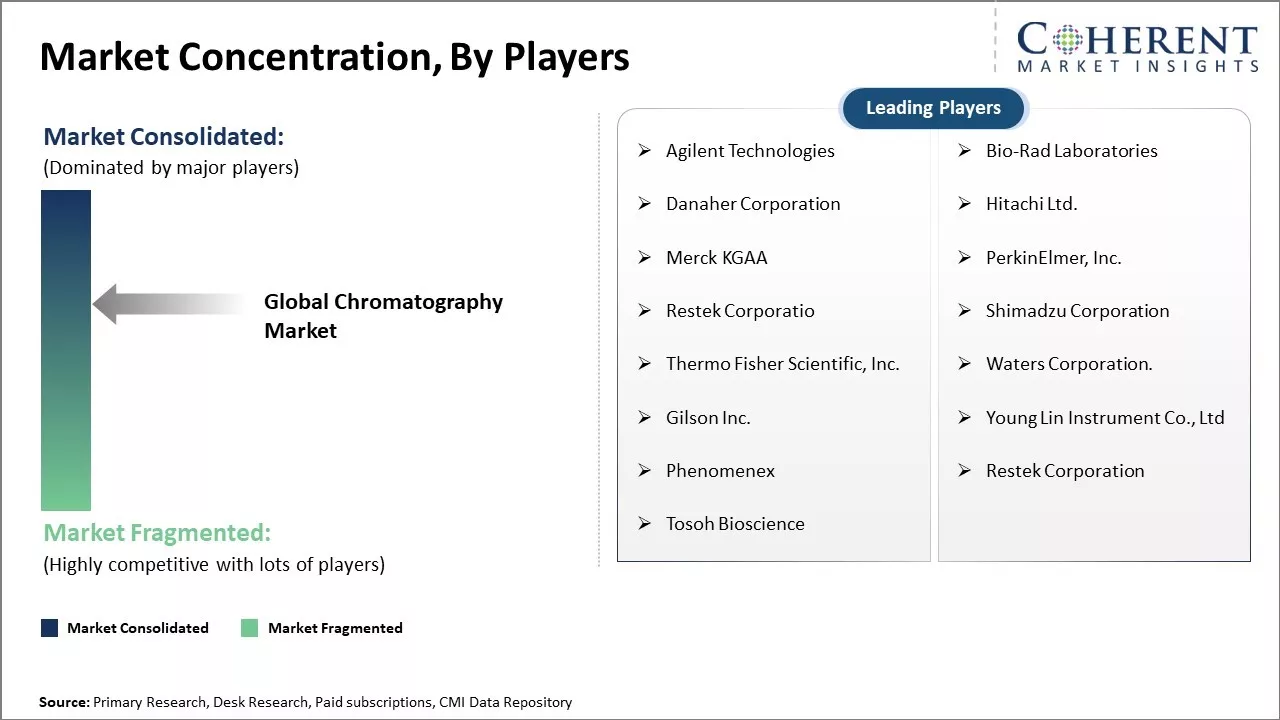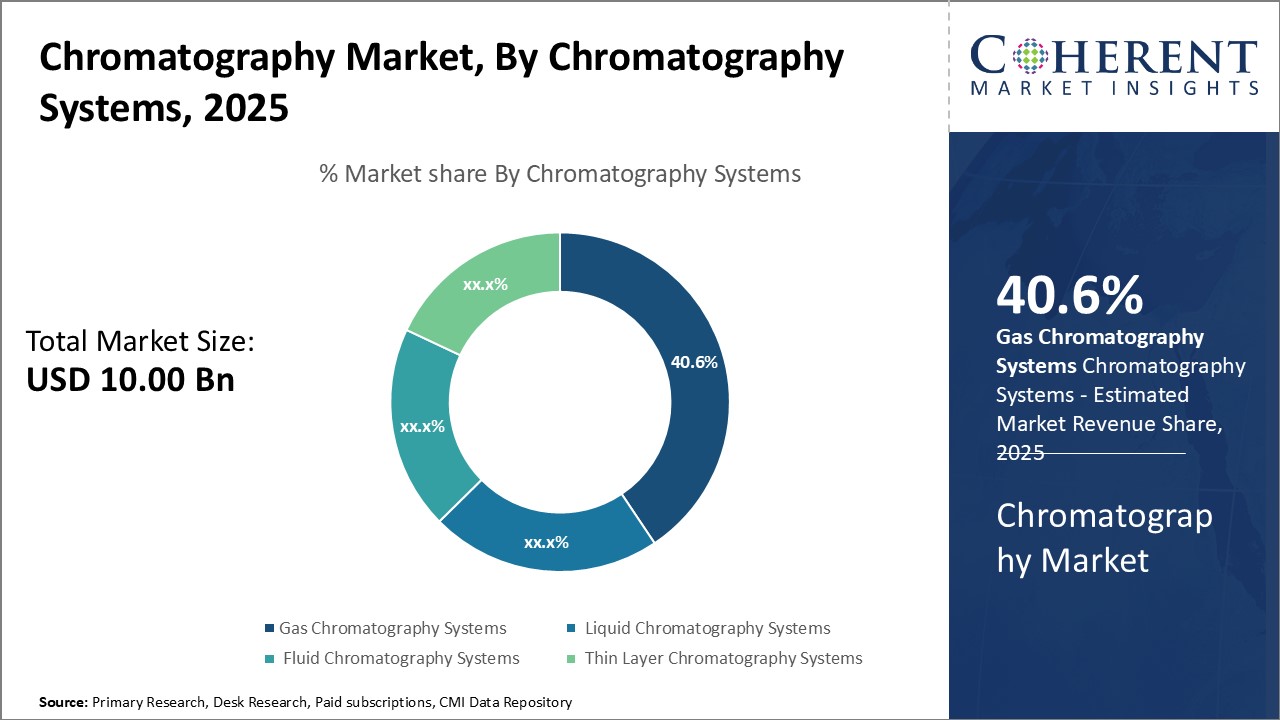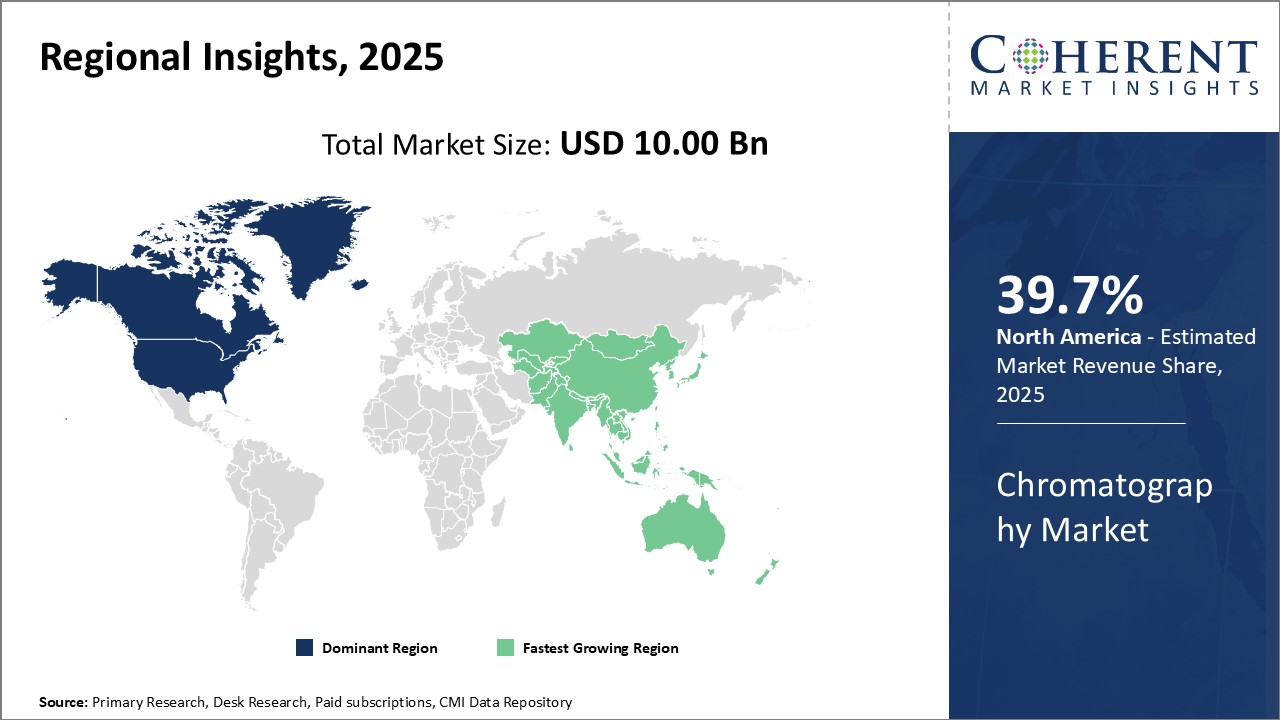
Global chromatography market is estimated to be valued at USD 10.00 Bn in 2025 and is expected to reach USD 14.37 Bn by 2032, exhibiting a compound annual growth rate (CAGR) of 5.3% from 2025 to 2032.

Discover market dynamics shaping the industry: Download Free Sample
Chromatography is used in various industries such as pharmaceuticals, food and beverage testing, academics institutes, and others. The market growth can be driven by increasing R&D investment in drug discovery by pharmaceutical companies. Growing concerns about food safety and increasing adoption of chromatography technique in proteomics and genomics research boosts demand for chromatography systems. Furthermore, technological advancements leading to miniaturization and automation of chromatography systems along with growing emphasis on analytical testing in industries like pharmaceuticals, biotechnology, and food and beverage can offer opportunities for the market players.
Increasing R&D investments in pharmaceutical and biotechnology industries
The pharmaceutical and biotechnology industries have increased their research and development investments in recent years, and this drives the global chromatography market growth. These industries heavily rely on chromatography techniques for drug discovery, development and purification processes. Chromatography allows them to efficiently separate, identify and purify biomolecules and chemicals, which is crucial for bringing new drugs to the market. According to the report published by OECD, the top 10 pharmaceutical companies spent over US$ 200 billion combined on R&D activities in 2021, indicating an increase of 15% as compared to 2020. These companies are aggressively working on developing advanced therapies like gene therapies, monoclonal antibodies and other targeted therapies to treat chronic and complex diseases. Chromatography plays a vital role right from the initial research and clinical trial stages to the final commercial manufacturing of such complex biologic’s drugs. There has been also huge demand for powerful analytical tools like liquid chromatography-mass spectrometry to support quality control testing requirements. For instance, in January 2025, ICON plc, a healthcare intelligence and clinical research organization, launched a whitepaper on optimizing biotech funding, highlighting trends in R&D strategies among biotech firms. A survey showed 60% plan to increase R&D spending, with clinical trials cited as a major challenge.

Get actionable strategies to beat competition: Download Free Sample
Developing healthcare sector
Advancements in medical research and technologies have enabled doctors and scientists to develop innovative diagnostic and therapeutic solutions for various diseases. Chromatography techniques plays a crucial role in numerous areas of healthcare such as drug discovery and development, disease diagnosis, blood analysis, and clinical trials. Chromatography enables the separation, identification and quantification of complex biological molecules and chemical compounds. This allows for a more thorough understanding of biological processes and pathological conditions at the molecular level. Rising healthcare expenditure and increasing governments’ investments in public health initiatives can boost demand for sophisticated medical testing and analysis. Healthcare facilities are expanding their in-house diagnostic capabilities through addition of new analytical instruments. Pharmaceutical companies rely heavily on chromatography at various stages of the drug development pipeline from target identification and validation to purity analysis of active pharmaceutical ingredients and impurities. With an aging population and rising burden of chronic diseases, the requirements from medical and pharmaceutical research are diversifying. This expanding role of chromatography across the healthcare industry boosts demand for newer and improved chromatography platforms. Various types of chromatography techniques such as Ion-exchange chromatography, Size-exclusion chromatography and Gas chromatography are used in the healthcare sector, and this offers lucrative opportunities for chromatography instrument providers.
Key Takeaways from Analyst:
Global chromatography market growth is driven by increasing R&D investment in lifescience and pharmaceutical industries. Rising need for advanced analytical techniques for drug discovery and development can boost demand for chromatographic equipment and consumables. North America and Europe currently dominate due to presence of leading pharmaceutical companies and rising research activities. Asia Pacific is expected to emerge as the fastest growing region due to rising generics market, growing biopharmaceutical industry, and increasing healthcare spending.
While developed markets offer huge potential, pricing pressure due to austerity measures can restrain market growth. However, technology advancements leading to cheaper, automated and high-throughput systems can address this restraint. Liquid chromatography is expected to remain the major revenue generator owing to its wide application in production, quality check and detection of impurities in pharmaceutical manufacturing. Rising demand for gas chromatography from food testing industry offers new growth opportunities.
Adoption of hyphenated techniques integrating two or more separation mechanisms is gaining popularity. Growing importance of quality by design approach in pharma industry will further boost demand for supportive analytical tools and services.
Market Challenges: High costs associated with chromatography instruments
The high costs associated with chromatography instruments can hamper the global chromatography market growth. Chromatography techniques require expensive and sophisticated instruments that need substantial capital investment. These instruments such as liquid chromatography, gas chromatography systems, and preparative chromatography equipment have a high price tag ranging usually between US$ 50,000 to US$ 500,000. The maintenance and repair costs of these instruments are also substantial, which further adds to the operational expenses of research laboratories and industries. The rising costs have made chromatography inaccessible for small and medium scale research facilities as well as industries with limited resources. While chromatography provides high quality analytical data and is indispensable for research and process development, its high capital expenditure acts as a deterrent, especially for cash-strapped startups, and resource-constrained public research institutions in developing countries. This has restricted the adoption of chromatography techniques to well-funded private laboratories and large multinational companies.
Market Opportunities: Increasing importance of quality by regulatory agencies
Increasing focus on quality control and regulation by various agencies around the world can offer opportunity for global chromatography market growth. Strict norms and standards introduced by bodies like FDA and EMA have compelled pharma and biotech companies to incorporate robust quality testing methods at various stages of drug manufacturing. Chromatography techniques like HPLC and GC have emerged as go-to technologies for companies to ensure product quality as per regulatory specifications in a reliable, reproducible manner. Agencies are also mandating more frequent quality checks and advanced analytical testing for a wider range of industries beyond pharma/biotech like food and beverage, chemicals and petrochemicals. For example, the European Commission updated standards for pesticide residue limits in food, and introduced new MRLs for 67 pesticide-commodity combinations based on toxicity risk assessments (European Commission, 2022). Such measures encourage the use of chromatography among food producers and exporters to validate compliance with global food safety norms. The trend of globalization of trade and rising consumer health awareness has also increased pressure on brands to maintain high transparency regarding ingredients, chemical content and sources of raw materials

Discover high revenue pocket segments and roadmap to it: Download Free Sample
Insights, By Chromatography Systems- Increased Sensitivity and Specificity Boosts Demand for Liquid Chromatography Systems
In terms of chromatography systems, liquid chromatography systems segment is estimated to contribute the highest market share of 40.6% in 2025, owing to its high sensitivity and specificity. Liquid chromatography provides better separation of complex chemical mixtures as compared to gas chromatography due to its ability to handle polar and thermolabile compounds. It is the primary analytical technique used in various industries such as pharmaceutical, biotechnology, food and beverages. Liquid chromatography systems offer separation of ionic and polar compounds, which are not easily separated by gas chromatography. These provide highly reproducible results along with quantitative and qualitative analysis capabilities. Advancements in column technology have improved separation efficiency and detection limits of liquid chromatography systems. Wide range of stationary phases are now available for optimizing separations of biomolecules such as proteins and peptides. Monolith columns provide high permeability for fast analysis while maintaining high resolution. Increased use of High-Performance Liquid Chromatography (HPLC) and Ultra Performance Liquid Chromatography (UPLC) techniques have further enhanced productivities in various applications such as natural products analysis, chiral separations, and impurity profiling. Integration of tandem mass spectrometry with liquid chromatography also allows identification of unknown compounds.
Insights, By Consumables & Accessories - Increasing Throughput Needs Boosts Demand for Columns
In terms of consumables & accessories, columns segment is estimated to contribute the highest market share of owing to the need for increased throughput. Chromatography columns are considered consumables as these need to be replaced periodically based on usage. With growing sample complexity and analysis needs across different industries, there is constant demand for columns that can provide high peak capacity and resolution in short cycle times. This has driven innovations in column packing materials, particle sizes and formats. Use of sub-2μm particle sizes in columns have significantly improved separation efficiencies and reduced analysis run times. Wide selection of column diameters and lengths also allows optimization based on specific application needs. Ready- to- use column formats eliminate tedious packing steps, thus, improving lab efficiencies. Development of monolithic columns provides an alternative to particle packed columns with benefits such as high permeability for ultra-fast separations. Specialized column chemistries are also available for capturing particular analyte classes like proteins, peptides and antibodies. The need for sensitive and high throughput analysis techniques can boost demand for advanced column technologies.
Insights, By End User - Regulations Drive Adoption in Pharmaceutical Industry
In terms of end user, the pharmaceutical & biotechnology company segment is estimated to contribute the highest market share of, owing to stringent quality regulations. Chromatographic techniques like HPLC, GC, and LC-MS play a vital role across different phases of drug development and manufacturing. At the research and development stage, these techniques are used for identification, quantification and isolation of active pharmaceutical ingredients (APIs) and impurities. During the quality control and quality assurance stages, chromatographic methods are essential for testing raw materials, in-process samples, finished drug products and ensuring batch-to-batch consistency. Stringent regulatory frameworks enforced by agencies like U.S. FDA and EMA mandate use of chromatographic techniques for compound identification, purity testing, stability studies and dissolution studies. These are also a mainstay for cleaning validation, bioburden testing and environmental monitoring protocols required for licensing. Given large capital investments required, pharmaceutical companies prioritize techniques like HPLC, GC-MS and LC-MS/MS to address diverse analysis needs efficiently and comply with regulatory protocols. Chromatography thus enables manufacturers to develop and commercialize new drugs while meeting all quality standards.

Need a Different Region or Segment? Download Free Sample
North America has established itself as the dominant region in the global chromatography market with an estimated market share of 39.7% in 2025. With the presence of major pharmaceutical and biotechnology companies, North America has led research and innovation in the field. The region is home to several top chromatography instrument manufacturers and suppliers. Companies based in the U.S. and Canada have introduced many new technologies that have found widespread adoption globally. Furthermore, laboratories in North America actively utilize chromatography techniques for research as well as quality control and assurance purposes. Strong funding for healthcare related research from government bodies as well as private sector also drives the market growth.
Asia Pacific has emerged as the fastest growing regional market for chromatography. decade. Countries such as China, India, Japan and South Korea have witnessed immense development of their pharmaceutical, biologics and chemicals sectors. All major industries where chromatography finds application have experienced rapid capacity expansion. This has boosted demand for chromatography instruments, consumables and services. Contract research and manufacturing organizations based in Asia Pacific have consistently won business from global pharmaceutical companies, further boosting regional chromatography usage. Governments of Asian countries have also prioritized development of domestic healthcare industries through incentives and initiatives aimed at boosting manufacturing and R&D capabilities. This has provided the necessary environment and opportunities for the chromatography market growth. The region's low production costs and availability of highly skilled professionals have further strengthened Asia Pacific's position as the fastest developing chromatography hub worldwide.
Chromatography Market Report Coverage
| Report Coverage | Details | ||
|---|---|---|---|
| Base Year: | 2024 | Market Size in 2025: | USD 10.00 Bn |
| Historical Data for: | 2020 To 2024 | Forecast Period: | 2025 To 2032 |
| Forecast Period 2025 to 2032 CAGR: | 5.3% | 2032 Value Projection: | USD 14.37 Bn |
| Geographies covered: |
|
||
| Segments covered: |
|
||
| Companies covered: |
Agilent Technologies, Bio-Rad Laboratories, Danaher Corporation, Hitachi Ltd., Merck KGAA, PerkinElmer, Inc., Restek Corporatio, Shimadzu Corporation, Thermo Fisher Scientific, Inc., Waters Corporation., Gilson Inc., Young Lin Instrument Co., Ltd, Phenomenex, Restek Corporation, Tosoh Bioscience |
||
| Growth Drivers: |
|
||
| Restraints & Challenges: |
|
||
Uncover macros and micros vetted on 75+ parameters: Get instant access to report
*Definition: Global chromatography market involves the manufacturing, distribution and sale of chromatography instruments, consumables (columns, detectors, mobile phases), and services. Chromatography is an analytical technique used to separate mixtures and identify individual chemical components. Key products in this market include gas, liquid chromatography systems and columns for applications in pharmaceuticals, life sciences, food and beverage testing, and environmental testing. The global chromatography market is expected to grow steadily due to increasing R&D investments in pharmaceuticals and rising demand for analytical techniques in various industries.
Share
Share
About Author
Komal Dighe is a Management Consultant with over 8 years of experience in market research and consulting. She excels in managing and delivering high-quality insights and solutions in Health-tech Consulting reports. Her expertise encompasses conducting both primary and secondary research, effectively addressing client requirements, and excelling in market estimation and forecast. Her comprehensive approach ensures that clients receive thorough and accurate analyses, enabling them to make informed decisions and capitalize on market opportunities.
Missing comfort of reading report in your local language? Find your preferred language :
Transform your Strategy with Exclusive Trending Reports :
Frequently Asked Questions
Joining thousands of companies around the world committed to making the Excellent Business Solutions.
View All Our Clients